

The Radcliffe Coal Company was sited at Amble quayside, Northumberland 1875 - 1955 - P.J. Davison, Brickworks of the North East.


Photos by Chris Tilney.

Photo by Mark Cranston

Photo by Edith Stewart.

Photo by Phil Jenkins.


Found Newark, Notts. Photo by Frank Lawson.

In 1876 Samuel Jefferies is described in a Gloucestershire Directory as "coal merchant and brick manufacturer, Railway Coal Wharf, and Railway Standard and Light-pill Brick Works". Photo by Steve Burrell.

Rainbow was a trade name of Samuel Evers & Sons, Homer Hill works, Netherend Lane, Cradley, Halesowen, West Midlands. Kelly's Worcestershire Directory 1892 - 1940. The red brick was made from colliery waste. The 1940 directory states that they were a branch of E J & J Pearson Ltd making Firebricks and Fireclay goods. The works closed around 1970. Photo by Martyn Fretwell.

Photo by Kaie Martin.

Photo by Angel Rose.

James Frederick Rainer is listed in Kellys 1894 to 1922 editions at the Cheshunt Brick Fields, Prospect Road, Chesham, Waltham Cross, Herts. A second works at Enfield Highway is listed in Kellys 1899 to 1912 editions. Photo & Info by Martyn Fretwell.


Rainford Brick & Tile Works, Rainford, St.Helens, Lancs. Slater's Directory 1895

Colin Driver writes: I recently found the above in Littleborough
very near to the former Rake Inn at the bottom of Blackstone Edge
Old Road. Further enquiries resulting in me finding a listing in
MacDonald's 1879 Directory of the "RAKE FIRE BRICK COMPANY - Halifax
Road,Littleborough. Formed in the early 1860s, in 1886 the business is listed as makers of sanitary tubes,fire-bricks, tiles, chimney pots, boiler seatings, blue bricks, ridge tiles, coping &c. They also had a depot at Lees Street in Ancoats for sales around Manchester. In 1889 the Rake brickworks passed to the Littleborough Fire Clay and Coal Company under which it continued until closure in 1896.

Photo by David Kitching.

Richard Paterson writes: In their excellent book 'Herefordshire Bricks & Brickmakers' (Logaston Press, 2007), Edwin Davey and Rebecca Roseff identify Ralph, Preece, Davies & Co as owners of the Albert Brick & Tile Works at Holmer, Hereford. They quote an anonymous description, dated 1892, which states that the works had been 'established for about 50 years' and refer to another source which says that the demolition of the chimney stack was filmed in 1968 or 1969. Davey and Roseff suggest that, at one time, RPD may also have owned the Brickyard at Aylestone Hill, Hereford. Photo by PRBCO.











Photos by Steven Tait.

Photo by Mike Graham.

Messrs George Heppel Ramsay and Co, Fire Brick Works. The founder of this business, Mr. G Heppell, first established his brickworks at Derwenthaugh. Expansion plans were put in hand and the largest brickworks in the area were built, capable of completing 7 million bricks per annum. Clay used in the making of the bricks was transported from the colliery which was about 300 yards away. Photo by George Simpson.
In November 1880 J T Ramsay brick manufacturer at Derwenthaugh was reported as insolvent.



Photos by Chris Tilney.


Ramsay firebricks were exported across the world. These two examples were found in Kaliningrad, Russia by Vladimir.

This example was found in a fireplace on Denmark's Baltic coastline. Photo by Kjeld Ejdorf.

Photo by Tony Gray.
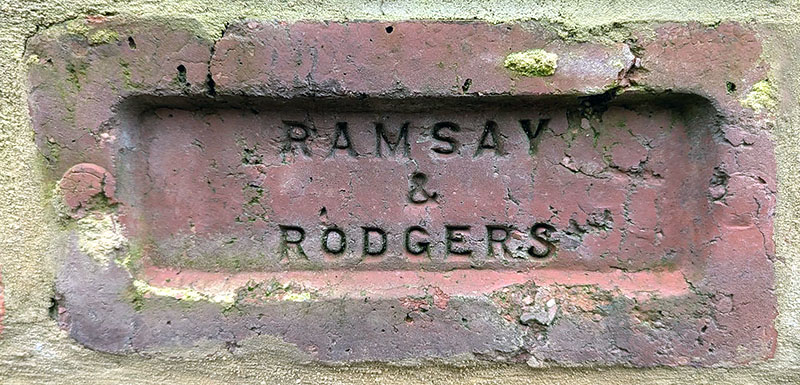
The Yorkshire Evening Post, 20 March, 1953 has an advert from Ramsay and Rodgers Brick Co., Ltd., Churwell near Leeds. The business seems to have taken over the Churwell Brick Works, off Old Road in Churwell which was advertised for sale in November 1950. At that time it had a 14 chamber Hoffmann Kiln with a capacity of 212,000 bricks. There was a Bradley & Craven brickmaking machine capable of making 1,200 bricks per hour. Photo by Louise Arundale.

Started in 1838 by the Botfield family in Stirchley, now part of Telford. It became the Randlay Brickworks in 1856. The brickworks closed by the end of the 1960's with the loss of 91 jobs. It was estimated that in the 1960s the brickworks could produce over 300,000 fiery red bricks in a week; sufficient to build 43 semi-detached houses. More info here: http://blackcountryhistory.org/collections/getrecord/GB149_D-SSW_2_AB/. Photo by David Kitching.

Photo by Phil Burgoyne.

Gareth found hundreds of these in woodland near Telford.


Randolph Colliery Brickworks, Evenwood, West Auckland, Co. Durham.
An example of a Randolph Colliery red facing brick, probably
produced from 'seggar' mined in the former Hutton seam. Although the
colliery dated to the late 1800's, the brickworks didn't start
production until 1931, remaining a private enterprise despite
Nationalisation of the coal workings, before finally closing in
1958. Photo and info by Arthur Brickman.

Photo by Chris Tilney.

Raven & Hitcham were active as builders and contractors around Gateshead from the 1890s to 1916. This brick will have been made for them by one of the local brickworks. Photo by Narbi Price.

Photo by Peter Lea.

Photo by Jase Fox.


Photos by courtesy of the Frank Lawson collection.

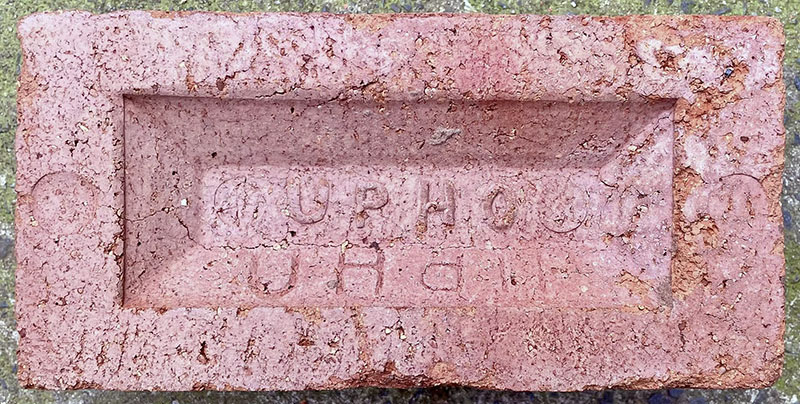
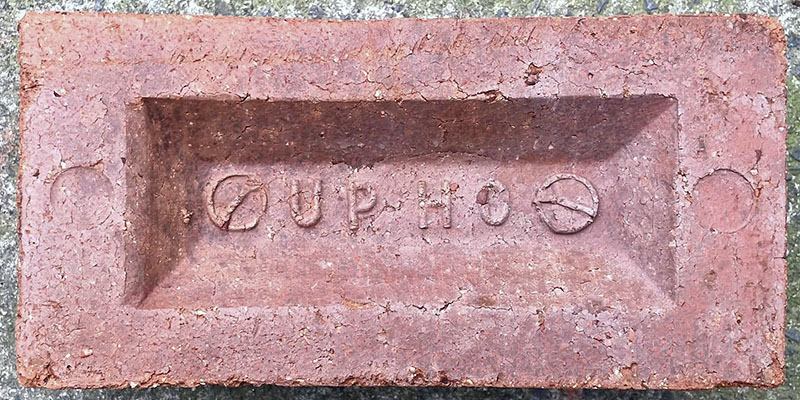
Photos by Phil Burgoyne.

Photo by David Kitching.

Found in a salvage site in Bolton by Henry Lisowski.

Seen on a house built 1935. Photo by Iain Taylor.

Photo by Henry Lisowski.

Photo by Don Boldison.
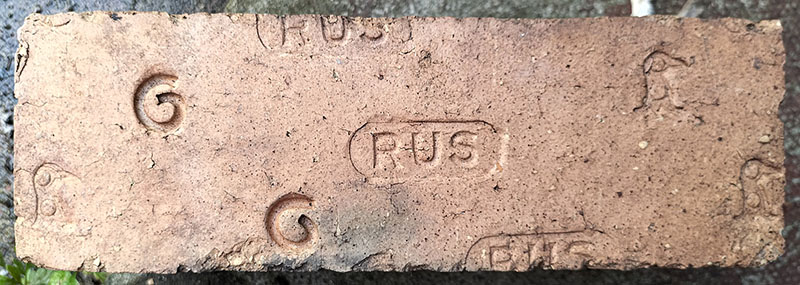
Ravenhead Rustic. Photo by Philip Wilkinson.


Both found on the seashore at Crosby, Merseyside.

Fiona photographed this one in Bootle.
John Harrison has discovered that all the above are products of the Ravenhead company. Their 1922 products book can be read here.

Found in a wall built in 1928. Photo by Friends of Williamson's Tunnels, Lynn Mills.
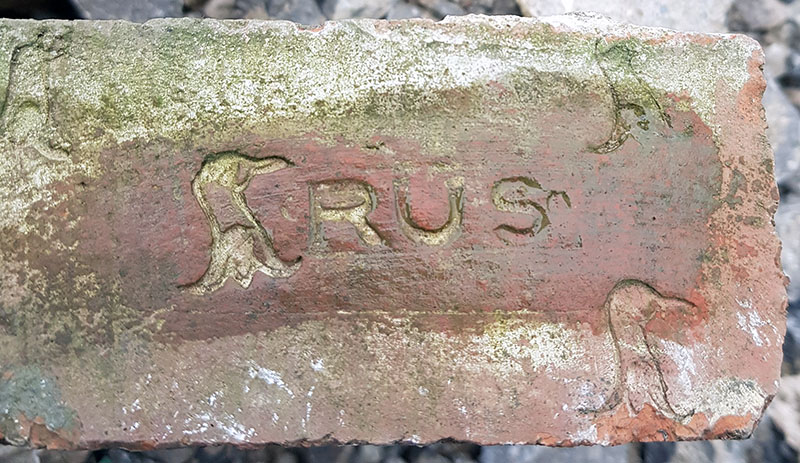
Photo by Phil Headford.



Richard thinks the W represents the Whitaker Brick Co., the owners of the works.
Ravenscar is a village around 12 miles north of Scarborough and has been described as 'the town that never was'. At the end of the 19th Century a development company bought the headland with a view to developing a town that would rival Scarborough and Whitby as a resort. Drainage was put in, ornamental gardens created, streets laid out and named and the nucleus of a shopping centre and a few houses were built, but the investors were unimpressed. The town for which Ravenscar Brickworks was established in 1900, by the Whitaker Brick Co, was never built. Nevertheless, the brickworks, set up in an old Alum Quarry, continued in production into the 1930s and, with the benefit of its own railway siding, provided bricks for, amongst other projects, the former Odeon Cinema in Scarborough. Though the two chimneys were demolished by the military in 1960, the substantial remains of the Hoffman kiln remain on land now owned by the National Trust. Photos and information by Richard Paterson.


Photos by Chris Tilney.

Joseph Rawcliffe came from Yorkshire to Barrow in Furness to manage a brickworks for builder William Gradwell. In 1857 he opened his own brickworks and also operated as a builder, specialising in public houses. The business closed when he died in the 1890s. Photo and info by Kevin Alexander.




The Rayleigh Brick Co. Downhall Road, Rayleigh is listed in Kellys 1929 to 1938 editions with Lamb & Son recorded as proprietors. History of the works at this Link. http://www.rochforddistricthistory.org.uk/page/lambs_brickfields_rayleigh Photos & Info by Martyn Fretwell.


The Rayner family appears to have been involved in brickmaking in Gestingthorpe since at least 1863 when John Rayner is listed as a brickmaker in White's Essex Directory. Subsequent Essex Directory listings of Rayner brickmakers are as follows: -
1874 - 1894, Mrs Elizabeth Rayner, Gestingthorpe
1904. William Rayner & Co., Castle Hedingham, Halstead
1914, John Frederick Rayner, Gestingthorpe, Castle Hedingham
As the initials are missing from this brick it is difficult to determine which one of the Rayners might have produced it but its early age might suggest that it was either John or Elizabeth. Photos and info by Frank Lawson.

The history of this brickworks, the forerunner to the London Brick
Co. in this area, is as follows;
1847 There was a local brick maker near Newton Longville.
1890 Thomas Read & Son acquired the works, later to be joined by
Richard Andrews, so Read & Andrews formed.
1919 Joined by builders merchants W. T. Lamb & Sons.
1921/2 Became the Bletchley Brick Co.
1925 Started to produce 'flettons'.
1929 Purchased by London Brick Co. & Forders.
1933 New works were constructed on the opposite side of the
Newton Longville to Bletchley road.
1936 Name changed to London Brick Company.
1943 Taken over by the Ministry of Supply to store ammunition in the
kilns, an ordnance depot was established.
1984 Became part of the Hanson Trust.
1991 November. Works closed. Photo and info by Nigel Furniss.


The Redbank Brick Company is recorded in Kelly's for 1895 and was on Atherstone Road along with two other brickworks - Measham Terra Cotta & Coronet. The company may have taken its name from nearby Red Bank Farm. In 1955 the company produced bricks and pipes. 1983 saw the company expand to produce tiles, chimney pots and terracotta. Now owned by Hanson this works closed in 2009 to be replaced by an ultra modern automated brickworks on adjoining land. The business is now owned and operated by Forterra.
Aerial photo from 1933 with Redbank in foreground with
Coronet works on other side of railway line. Info by Martyn
Fretwell.

Photo by Martyn Fretwell.

Photo by Frank Lawson.

Both found in North East Derbyshire. Hanson have opened a '50 million brick factory at Measham in Leicestershire built on the landfill and stock site of the old Red Bank brick works. This new factory has the capacity to produce 100m bricks a year with just 28 people. Thanks to Simon Patterson for the photo and information.

Photo taken by Jo Roesen at Broadway station Worcs, read their blog here.

Photo by Steven Pinder.

Photo by Stephen Haynes.



Red Hill Bank brickworks was established in the 1890s alongside another brickworks, the Rocester Works adjacent to Rocester Station. By 1922 the two establishments appear to have amalgamated into one works which was still in business in the mid 1950s. The site is now occupied by the JCB factory. Photos by Frank Lawson, info by David Kitching.

Crowle is near Scunthorpe in Lincolnshire. Photo by Frank Lawson.




In 1894 Drakehouse Colliery, Beighton was owned by Edmund Reddish & Co. and it is likely that they also owned a brickworks on or near the colliery site as I have seen references to a brickworks on Drakehouse Lane. Kelly's Derbyshire Directory 1899: - Gregory Reddish & Co Ltd., Beighton, Sheffield. White's Sheffield & Rotherham Directory 1901: - Edward Reddish, Beighton, Sheffield. Gregory Reddish Co Ltd of Deepcar, Sheffield are listed as brickmakers in Whites Directory of 1919. Photos & info by Frank Lawson.

Photo by Guy Morgan.



In 1918 and 1939 Gregory Reddish and Co Ltd. was advertising silica bricks from its works at Deepcar, Sheffield. Photos by Ian Suddaby.




A product of the Redheugh Brick Company, their
works on the Teams, a tributary of the Tyne near Dunston on the
outskirts of Gateshead, ceased production around 1915, the
company having only been in existence for some 35 years. Photos by Chris Tilney.


Photos by Steven Tait.

Photo by Mike Graham.


Photos by Chris Graham.

Photo by David Kitching.


Found around the Hayling Island / Langstone Harbour shoreline in
Hampshire by Tony Russell.

Photo by Mark Howard.

James Redrobe was advertising his bricks in the local papers in 1877 although his main trade was as a slater. This paver was photographed by Mike Shaw.

The Rill Park Brick & Tile Works
was producing from 1863 - 1900. It was situated on land near to
Marpool Hill, purchased from the Rill estate. Photo and information by Simon Fogg.

Photographed at Beamish Museum. This may be connected to William Reed in the entry below. Photo by Martyn Fretwell.

William Reed, St Helen Auckland, is listed in trade directories as a brick manufacturer in 1879 and 1890 and also in the 1891 census. In the 1881 census he is listed as a grocer and draper. The 1891 Kelly directory lists two more brickmakers with the name William Reed at Eldon Lane and Fylands Bridge, both close to Bishops Auckland. In the absence of any other information I believe that these are probably both the same man and that the St Helen listing is his home address. Photo by Chris Tilney who found this in Bishop Auckland.

Spotted in a wall in Southsea, Hampshire by Nigel Furniss.

Regis Brick Company, Blackheath, Staffordshire. The works was close to Rowley Regis and Blackheath Station and was trading under the name Regis Brick Co Ltd by 1933. The works was closed in 1964 and demolished over the next five years.

Found on Tyneside, photo by Steven Tait.

Photo by courtesy of the Frank Lawson collection.

Monkhill Lane Brickworks, Pontefract. Photo by David Kitching.

Thomas Rhodes had fingers in many pies, his main business was in the production of galvanised iron buckets & caustic soda drums etc at his Providential Foundry & Sheet Metal Works in Lye, Stourbridge, which he took over from Richard Rhodes in 1865. He also owned a grocers shop which his wife ran & he was also a Publican. His brickworks was situated between Dark Lane (now Chapel Street) & Pedmore Road in Lye & from newspaper articles was operational roughly between 1874 & 1891 producing fire-clay bricks then later red, white & blue bricks.
It appears from several newspaper adverts that Thomas Rhodes venture into brick making was not that successful as he was constantly advertising for brick makers & brick burners or letting his brickworks. Samuel Warr of Cradley leased the works between 1879 to 1882, (Warr had previously operated a brickworks at Holmer Hill). In 1883 Rhodes tried to sell his brickworks as a going concern, but this appears not to have happened as we find a July 1888 advert records Rhodes was selling 70,000 common red bricks at the Lye Cross Red Brick Works, which was then be Let. Another advert & the last dated July 1891 records Rhodes was once again letting his brickworks. I am assuming this works closed in the early 1890’s.
This works is also recorded as the Dark Lane Fireclay & Brick Works. Rhodes' galvanised bucket & sheet metal works closed in 1906 & this business together with all it’s machinery were moved to Belgium with Rhodes taking up the position of manager.
Photo & Info by Martyn Fretwell.

Charles Richardson's brickfield was at Teynham, Kent with his cement works at nearby Conyer. Using his own barges to transport his goods, he owned wharves at Vauxhall and Conyer. In the early 1880’s Richardson joined forces with John Francis Eastwood and four others to form Eastwoods Co. Ltd. supplying bricks to London, Kent and Essex by barge. An ever expanding Eastwoods went on to own many brickworks in Eastern and South-Eastern Counties of England including making Fletton bricks at Peterborough. See entry for Eastwoods. Photo by Tim Richardson.

Herbert John Richardson is listed in Kellys 1899 edition at the
Danbury Brickworks, Danbury, Chelmsford, Essex. The entry in Kellys 1902 to 1910 editions is Richardson Brick & Tile Co. (Danbury) Ltd. Photo & Info by Martyn Fretwell.

John Hunter & T Richardson, Rabbit Banks, Gateshead and Dent's Hole - Ward's Newcastle Directory 1850. In 1856 Richardson was still occupying the Rabbit Banks firebrick works. The business at Dents Hole was originally run in partnership between J H Richardson and John White until this was dissolved in April 1832. Photo by Tony Gray.

I believe this to be an incorrectly stamped Richardson brick where the 'H' has been replaced with 'M'. Photo by Chris Graham.


Photos by Steven Tait.




Photo by Chris Tilney.


It appears Riddings bricks where made in Jacksdale, Notts, by James Oakes & Co. (Riddings Collieries) Ltd. He owned several collieries, a very large iron works, situated next to the Cromford Canal and on another site next to Pye Hill Colliery, he manufactured clay pipes and bricks. The Oakes family lived at nearby Riddings House, an 80 acre estate in Riddings, Derbyshire. Nothing is left to see, on either site, to remind us of these glory days of manufacturing, only his bricks! Info by Martyn Fretwell.




Photos by Frank Lawson

Derek Barker writes: This brick was made by Daniel Riddiough. Unless I am very much mistaken brick-making seems to be the least of his accomplishments. Daniel Riddiough was born in Colne, Lancs and was also a builder and quarry owner in the Otley Rd/Killinghall Road area of Bradford. He seems to have owned what was called the Peel Park Brewery, Otley Road built in 1853. Apparently he sold this concern in 1872, but then bought it back after the new owners went bankrupt in 1882. In 1891 he finally sold out his brewery and 17 pubs to Hammonds Bradford Brewery Co Ltd but continued as a brick-maker, perhaps until he died in 1911. The brick works included a circular Hoffmann kiln and are well marked on contemporary maps at at Cliffe Lane, Bolton Road.

Photo by Thomas Hayman.

Photo by courtesy of the Frank Lawson collection.


The Ridge Hill Brick and Tile Co works was in Madeley, Staffordshire. First mentioned in 1848 when it was operated by John Kennerley a local farmer. The business operated under the same name until just before 1912 when it changed to Brick & Tile Workers Ltd. The site is still in use by Marley-Eternit producing hand and machine made clay tiles. Photo and information by David Kitching.

Reading and Staines seem to be manufacturing locations. Photo by Nigel Furniss.

Photo by Mike Graham.




Spotted in Riddings, Derbyshire by Martyn Fretwell who thinks it may have been made by Slack of Ripley.

Made at the Walkley Lane Brick Works which was owned by Henry Ripley. These were operational from 1900 to 1904. Photo by Frank Lawson.

Ripley seems to have had a Loxley works at one time as well as that at Hillsborough. Photo by Malc Gibbons.
.jpg)

H.Ritson was an owner of a
Carr House Firebrick Works as well as the South Pontop Colliery,
both at Consett, in the 1850s and '60s. Info by
Ian Hunter, photo by Steven Tait.
See the R Dickinson entry for a later product from Carr House Works.


Photos by Chris Tilney.


The Ritson family owned Burnhope Colliery from the 1880s to the 1930s. The founder of the business who bought the colliery from Fletcher & Sowerby was Utrick Alexander Ritson. Photos by Chris Tilney.

Made at Preston Colliery, North Shields near Newcastle. Photo by Chris Tilney.



John Roberts was a brickmaker in Alrewas in the 1861 census. The 1872 Kelly's trade directory lists John Roberts, Hilliard's Cross, Alrewas, Lichfield whilst the 1876 edition has him at Streethay but I think this is the same location. By 1880 the business had become John Roberts & Son. The 1881 census lists John as a retired brickmaker and the business does not feature again in directories. Photo by Angel Rose.

Photo by Bill Duff.

Photo by Jeremy Nutter.


William Roberts, Bricklayer, Builder & Brickmaker, 70 Plumbe Street, Liverpool. Gore's Liverpool Directory 1853. Images and info from Frank Lawson.

Photo by David Kitching.

Anthony Roberts' brickyard was on Furlong Road opposite the Greengates Pottery and was later known as Newfield Marl Works. It is only mentioned in the 1875-76 trade directory and is not listed in 1873-74 or 1879, by which time the works was being run by Charles Salt. Photo and information by David Kitching.


Possibly from Lancashire.

Charles Robinson is listed as a brickmaker in Barlborough, Derbys in Kelly's 1908 edition. Photo & Info by Martyn Fretwell. Photo by Martyn Fretwell.



Edward Robinson was a builder and contractor in Belper from the 1830s to the 1860s and he is likely to have operated the works at the opposite end of Becksitch Lane to that run by W Brown. Info by Martyn Fretwell, Photos by Ian Brownson.

George Robinson & Son, Crowle Brickworks, Crowle Wharf, Scunthorpe, Lincs. Info by Frank Lawson.







James Robinson & Son (Sheffield) Ltd, Blagden Street, Park, Sheffield - White's Sheffield & Rotherham Directory 1911.
James Robinson is listed in other Sheffield directories as follows: -
1856 - James Robinson, Intake Road, Sheffield
1862 - James Robinson, Park View, Intake Road, Sheffield
1879 - James Robinson & Son, Duke Street, Park, Sheffield
1905 - James Robinson & Son, Blagden Street, Sheffield
Photos and info by Frank Lawson.

Photo by Andrew Richards.

Photo by Richard Carr.

Photo by David Kitching.

Ernest Robinson, Tachbrooke, Leamington,Warwickshire,1888-1900. Photo & Info by Martyn Fretwell.

Photo by Ian Castledine.

George Robinson, Wortley Road, Masbrough, Rotherham is listed as a brick manufacturer in Kelly's Sheffield & Rotherham Directory 1893. Kelly's West Riding Directory of 1881 records - James & George Robinson, Wortley Road, Masbrough, Rotherham as Brick & Tile Makers. An obituary notice in the London Gazette dated November 13th 1885 records the address of the brickyard as North Greaves Brickyard, Masbrough, Rotherham. Info by Frank Lawson, photo by Ray Martin.
Found by Ray Martin at the postal sorting depot at Sutton Coldfield Park Station, originally built in 1942 as the USAAF Postal Depot. During WW2, all US forces post to and from Europe was sorted at this depot. After the war it was taken over and extended by Royal Mail.



Robert & William Robson, Newcastle upon Tyne, 1863-1908. Photos by Chris Tilney.

Photo by Chris Graham.


Photos by Mick Hall.

Thought to be from the works of John Robson at Hunwick, County Durham. In the mid-1850s Robson was a builder and quarry owner in the area as well as a brick manufacturer. Photo by Chris Tilney.

Found at Seaton Burn. This may be Robert Robson, Burnmoor Tilery, Burnmoor, Chester le Street, Co. Durham. Slater's Commercial Directory of Durham, Northumberland & Yorkshire 1855. Photo by Frank Lawson.

Photo by Ross Chisholm.


The Robson family seem to have started as builders in Darlington and then expanded into brickmaking. Thomas Robson was a builder in 1841 and his son Thomas is subsequently recorded as a builder in 1851. By 1855 he seems to have gone into brickmaking, at a works off Brunswick Street in Darlington, in partnership with Christopher Oxendale a local timber merchant whose father was previously a builder too. In 1861 he describes himself as a Builder and Brick & Tile maker employing 24 men and 3 boys. His son Richard C Robson seems to have taken over the running of the business by 1875 and was still described as a Brick & Tile manufacturer in 1881. Also in 1861 James Clearby Robson, brother to Thomas Robson junior is also described as a Brick & Tile manufacturer employing 19 men and 14 boys. There were several brickworks around the end of Brunswick Street and his is likely to be one near to that of his brother. These works disappeared before 1890 as the area was built over. The brickworks from which Richard C Robson produced this brick for the 1875 Pilmore Bridge over the River Tees at Rockcliffe, near Darlington now lies beneath Borough Road. Photo by Michael Chapman.

Thomas Robson & Co ran a brick works at Botcherby, Carlisle, from 1832 till 1863. The reverse of this brick shows that Mr Robson had brickmaking machinery using Percy's Patent improvements. Info & photo by Graham Brooks.

Photo by David Kitching.


Rainhill is close to St Helens. In the 1881 census John Roby is described as Brass Founder & Brick Maker Employing 29 Men & 3 Boys.

Helena writes: I am after the dates this was known as the Rocester Brick Co ltd. I believe this became the Red Hill Works. Can you help?


Photos by David Kitching.

Photo by Lyn Bostock.



Photos by Frank Lawson.

Photo by Jason Stott.

Photo by David Fox.

Photo by Colin Driver.

Photo by Graham Shooter.



Rock Red Brick Co., Fraser Road, Burmantofts, Leeds. Kelly's West Riding Directory 1908. Probably associated with Rock Colliery (Burmantofts), Leeds. Owned by Wilcock and Co. The works was closed and dismantled in 1914 when items for sale included a Bradley & Craven No.1 brick making machine and a 20 chamber Hoffman Kiln. Photos by courtesy of the Frank Lawson collection.

This works was at West Wellow, Romsey, Hampshire. In 1867 a brick kiln is shown together with 7 long drying sheds. In 1875 the business was raising capital with an offer of a £5,000 in bonds of £50 & £100 each. 1876 - Advert for a tile maker wanted. 1877 advertising red or white bricks at the rate of 10,000 per day. 1879 - Sale of surplus stock by auction followed by liquidation in 1881. Photo and info by Nigel Furniss.

Made at the brickworks associated with Rodridge Colliery at South Wingate in Durham which was active in the 1860s. Photo by Chris Tilney.


Photos by Steven Tait.

George Roe of Cromford Road, Ripley is recorded in White's Directory for 1857. Photo & Info by Martyn Fretwell.



T. Roe & Son are listed
as making red bricks at Siddals Road, Morledge, Derby in Kelly's
1864 & 76 editions. Photos & Info by Martyn
Fretwell.





Romiley Brick & Terra Cotta Company. This business seems to have been short-lived. The works, to the west of the River Goyt and close to the Midland Railway does not appear on the 1907 revison of the OS maps and is disused by the 1917 revison. The last remains of the works was known to the locals as the 'Giant's table' and were not demolished until 1996. Photo by David Kitching.

Photo by Tom Jones.

Dureda was the
trade mark of the Romiley Engineering Brick Co according to
the 1931 List of marks, trade names and trade marks on bricks
tiles, stone and sanitary ware. Photo and info by David
Kitching.

Photo by Martyn Fretwell.

In 1876 the business was listed as George Warburton Lewis, Rosemary Hill, Cheslyn Hay, Walsall. Later it bexame G W Lewis Tileries Ltd., Rosemary Brick & Tile Works & Walkmill Tileries, Cannock, Staffs. This was followed by Rosemary Brick and Tile Co Ltd. of Rosemary, Coppice Lane, Cannock, Staffordshire. Manufacturers of clay products (bricks and roofing tiles). In 1984 Redland acquired the company. Photo by John Elliott.

Photo by Frank Lawson.

Photo by Tony Gray.


Photo by Martyn Fretwell
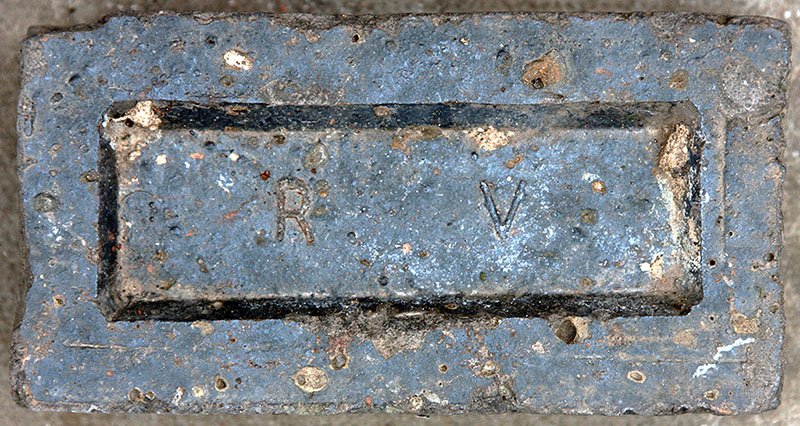
Rose Vale works was on Apedale Road in Chesterton which has origins before 1860 when run by Pointon. In 1875 it's Rose Vale Tile Company with James Downing as Managing Director. Pre-1883 - 1892 Rose Vale Brick and Tile Company. Frederick Hall, James Downing the younger, William Rowley, and Samuel Cork, carrying on business as Brick and Tile Manufacturers and Builders at Chesterton, under the style or firm of the Rose Vale Brick and Tile Company. 1892 business insolvent, receiving order was made January 14th, 1892 on debtor's own petition. Debts were £7,891 17s 10d. Creditors had lost 19s in of every £1 owned. Debtors had not kept proper books of account and had continued to trade after knowing themselves to be insolvent. By 1900 the site had been cleared. Photo by David Kitching.



Photo by courtesy of the Frank Lawson collection.

Photo by Jase Fox.



Found by Simon Patterson in Barlborough, Derbyshire and Harthill, South Yorkshire - only 2 miles apart. R V stands for Rothervale, the brickworks was at Thurcroft near Rotherham and was associated with Thurcroft Colliery which was owned by the Rothervale Company. Thanks to Frank Lawson for the info. Photos by Martyn Fretwell.


This brickworks at Battlies Green, Rougham was an estate brickworks belonging to Rougham Hall & was operational between 1890 & 1939. Info & Photographed at the Museum of East Anglian Life by Martyn Fretwell.

Photographed on the seashore at Crosby, Merseyside. Photo by Frank Lawson.


Roughdales Brick & Coal Co. Ltd., Sutton, St.Helens. Slater's St Helens Directory 1885. Info from Frank Lawson, photos by David Kitching.

Photo by Martyn Fretwell.




Probably Henry Rowbotham, Preston Street, West Gorton is listed in Slater's Manchester Directory for 1877. In 1879 he is listed at Wilton Terrace, Moston Lane, Harpurhey. The exact location of the brickworks is unknown. Henry Holt collected examples of this brick in Chadderton and Ellenbrook Street, Gorton. Photos by David Kitching.

Photo and info by Richard Symonds: Brickfield south of the former railway at Rowfant, nr Worth, Sussex. NGR TQ 330 365. In existence by 1875; marked as Rowfant Brick Works from 1912 onwards and said to have closed in the early 1960s, although it was referred to as Hundred Acres Brickworks, Turners Hill in 1972. James Terry advertised from 1875 to 1907. George Wells, who had another brickyard south of the former railway at Grange Road Station, Crawley Down, took over the yard. After WWII it was run by W. Harbour & Sons, of Copthorne. The map of 1910 shows a railway line into the works and 7 kilns: three circular and four rectangular.



William Rowland was operating a brickyard at Birch Lane, Dukinfield
in 1857. The letters I R D refer to John
Rowland, Dukinfield, his father, who died in 1856. Photos and info by David Kitching.


Rowland, Stapenhill. Found in Kellys Derby edition of 1876 only. Info by Martin Fretwell, photographed at Cawarden by Nigel Furniss.



Rowley & Co, Tunstall, are listed in a trade directory for 1872. The likely location is the Hollywall Tileries which were to let in 1869 and in the marl pit of which this brick was found and photographed by Ken Perkins.


Whiston is between St Helens and Liverpool.
Charles Phillips born 1816 in Badgworth, Somerset was already skilled at the potters wheel by the age of nine. John Mathews was a native of Scotswood in Northumberland. Mathews acquired the sole patent to Pooles patent bonding Roll Tile. Conway Gould Warne was formerly a potter in Rochester in Kent, Warne invented two new products, a land drain well and an electric cable trough. The Royal Potteries started probably around 1837. In 1847 the clay in Weston was pronounced by competent judges to be of better quality than any other in the country. By the late 1930s a thousand workers were employed there. In 1952 the Pottery received its last Royal order for 126,000 flower pots to be used in the Coronation displays around London. Weston pottery was then still considered to be the best in the country. The Pottery went into voluntary liquidation in November 1961. Thanks to John Biggs for the photos and information.





Royshaw Brickworks Co., Royshaw Brickworks, Blackburn. The brickworks was established in 1887 by William Matthews. It was rebuilt in 1932 by the Royshaw Brickworks Co.and was later taken over by John Woods Brick & Tile Co. Ltd. of Bog Height Darwen. It closed in the early 1950's. Info by Colin Driver.


Harold Tate, a builder and master brickmaker, started the brickworks at Rudgwick in Sussex c1928. After closure for the duration of the war and the death of Harold Tate in 1940, the Fawke family brought the works back into production in 1947. New machinery boosted production to 45,000 bricks a week and then in 1963-5, the works was modernised with an automatic brick making machine capable of producing 250,000 bricks a week. Baggeridge Brick PLC, based in bought out Rudgwick Brickworks Co Ltd in 1998, and in 2006 they in turn were taken over by Wienerberger who operated the works until closure in c2010. There were no kilns and the 1m brick clamps were still built by hand right to the end. Photo by Richard Symonds.
More information about the works can be found here.

Photo by David Fox.

Photo by Alan Murray-Rust

Photo by Mike Shaw.



Made in Stourbridge by Rufford & Co. A history of the business can be found here.

Rufus (Proctor Bros.) Brick & Tile Ltd, Newcastle-under-Lyme, Staffordshire. The brick yard opened by 1932 and was situated in the Bradwell Wood area near Parkhouse colliery (coal & clay). The yard also made roof and floor tiles and eventually closed in 1960. The clay (marl) in this area was dug out from the hillside of the woodland as opposed to the conventional method of extracting from marl holes. Thanks to Ken Perkins for the photo and history.

Photo by David Kitching.

The Rugby Brick Co., Ltd. is listed as a manufacturer of Common Bricks in the 1901 Directory of Clayworkers. The office address is given as 84, James Street, Rugby. It is also listed in the 1900 Kelly's Directory but not before or in 1904, so appears to have been a short-lived affair. The 1904 OS map shows a disused brickworks to the south-east of the town in the Bilton area. Photo by David Tilsley.




The works of Rushforth, Adwalton, is officially the 'Drighlington & Adwalton brickworks', south-west of Leeds; it is simple to find being now owned by a Brewers Fayre Restaurant. The original chimney remains as do a portion of the works buildings, now converted into a Premier Inn & Restaurant. Some memorabilia, in the shape of letters to Rushforths, are on display. This works is unquestionably the source of [RUSHFORTH][ADWALTON] bricks, very commonly found in Bradford 20th century buildings. Thanks to Derek Barker for the information. Photo by Frank Lawson.

Photo by Frank Lawson.

One of many variant stampings from this site. Works operated cl893 to c1985, Adwalton Brickworks, Drighlington, West Yorkshire. Image PRBCO.



Found in Leeds. Photos by David Kitching.

Found by the River Wharfe, not far from the village of Ryther, North
Yorkshire, by Carla van Beveren.

Found in Cheshire. Photo by Martyn Fretwell.

Photo by Mark Tilsley.

George Russell, Cadborough Brick and Tile Works, Rye, East Sussex.


Found by Hugh Owen on the foreshore near the site of the demolished Carmarthen Bay Power Station.
Neil Hanson writes: The Ryarsh brickworks was started by my father, Harold Hanson. Not sure of the year, but the majority of bricks produced were sand-lime white bricks. A much harder grey coloured brick was made, but was not favoured by builders as they preferred traditional red bricks. Both white & grey bricks were stamped RYK for Ryarsh Yard, Kent. My father was Managing Director at the yard when he died in 1953, but the works continued for several more years. The brickworks is shown on the 1936 OS map as being situated south of the village on School Lane, Ryarsh.



John Ryder & Sons Ltd., Brunswick Street, Ashton Road, Openshaw, Manchester. Slater's Salford & Manchester Directory 1895. Photos by Frank Lawson.

Photo by David Kitching.


Photos by Jason Stott.

Photo by Phil Burgoyne.
